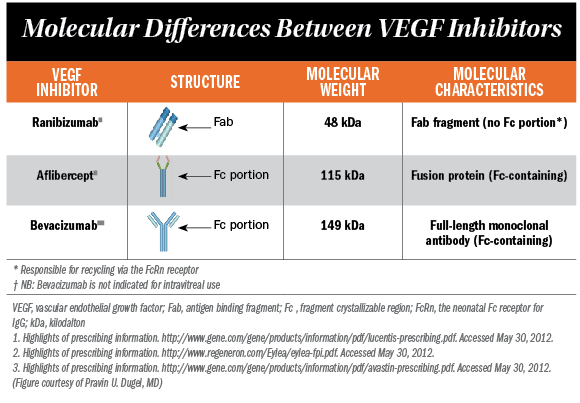Article
Anti-VEGF therapy: Identifying safety trends
Analyses of data from large clinical trials have been undertaken to determine how patient age and treatment-specific variables may influence the systemic safety of anti-vascular endothelial growth factor treatment.
TAKE HOME:
Analyses of data from large clinical trials have been undertaken to determine how patient age and treatment-specific variables may influence the systemic safety of anti-vascular endothelial growth factor treatment.

Dr. Pravin
By Cheryl Guttman Krader; Reviewed by Pravin U. Dugel, MD

While it is known that intravitreal treatment with anti-vascular endothelial growth factor (VEGF) agents can be associated with systemic effects, a paucity of statistically definitive data on this topic is the basis for ongoing controversy about the clinical impact.
Therefore, as clinicians aim to maximize the safety of anti-VEGF treatment for their patients, they should look to information pertaining to the most relevant risks in the most vulnerable patients, according to Pravin U. Dugel, MD.
Dr. Dugel, managing partner, Retinal Consultants of Arizona, Phoenix, reviewed the available data on the systemic safety of anti-VEGF therapy.
“We won’t ever have definitive clinical trials on the systemic safety of intravitreal anti-VEGF agents, and so it is all the more important now to look at the totality and directionality of the important trends in what is the most important of all issues for our patients-their safety,” said Dr. Dugel, who is also clinical associate professor of ophthalmology, Keck School of Medicine, University of Southern California, Los Angeles.
“We know we should be looking at major arteriothromboembolic events (ATEs), and we know that the most vulnerable patients, those 85 years and older, are at increased risk,” he said.
This 85-years-old and older population deserves emphasis, because safety trends that are pertinent to all patients may be seen in this group most clearly, Dr. Dugel noted.
There appears to be no drug or dose effect with ranibizumab (Lucentis, Genentech), but there may be a treatment regimen effect with ranibizumab, and there may also be differences in systemic exposure and safety profiles between the different anti-VEGF agents, he added.
At increased risk for ATEs?
The question of whether patients aged ≥85 years are at increased risk for ATEs with intravitreal anti-VEGF treatment was investigated in a logistic regression analysis using data from the ranibizumab MARINA and ANCHOR studies.
With patients stratified by age, ATE rates were higher among patients aged ≥85 years than in the younger cohort. This effect of age was confirmed in an analysis pooling data for patients treated with the commercially available dose of ranibizumab 0.5 mg in the MARINA, ANCHOR, PIER, SAILOR, and HARBOR studies, Dr. Dugel said.
Additional analyses of data from MARINA and ANCHOR showed no drug effect or dose effect comparing patients treated with ranibizumab 0.3 mg or 0.5 mg.
In addition, no dose effect was identified in the HARBOR trial comparing groups treated with ranibizumab 0.5 mg versus 2.0 mg.
However, an analysis of data from HARBOR showed a treatment regimen effect. Among patients aged ≥85 years, the ATE rate was higher among those receiving monthly injections compared with those being treated on an as needed basis.
Whether there are differences in systemic safety between the three most commonly used anti-VEGF agents is perhaps the most controversial question, Dr. Dugel said.
The three agents differ structurally-aflibercept (Eylea, Regeneron) and bevacizumab (Avastin, Genetech) contain the Fc portion of IgG1, whereas ranibizumab does not.
In addition, data from the IVAN study showed that bevacizumab caused more systemic VEGF suppression than ranibizumab, whereas a study by Yu et al. showed that the two Fc-containing agents, aflibercept and bevacizumab, achieve a higher serum concentration than ranbizumab.
Serious adverse event rate
Comparative data on serious adverse events (SAEs) was first provided by CATT. In that study, bevacizumab-treated groups had a higher SAE rate than the ranibizumab groups, and the difference between groups continued to increase over time.
“However, it was puzzling that among bevacizumab-treated patients, the rate of SAEs was higher among those receiving prn injections than in the monthly treatment group,” Dr. Dugel said.
More recently, data from the VIEW studies comparing ranibizumab and aflibercept was released in the European Public Assessment Report. Analyses focusing on patients aged ≥85 years showed that after 1 year, the rate of cardiovascular events was higher among ranibizumab-treated patients whereas the rate of cerebrovascular events was higher among patients treated with aflibercept.
During the second year of the study, the between-treatment difference in cardiovascular rate trended to normalize, but the difference between groups in cerebrovascular event rates remained.
“Do these data mean that the Fc-containing drugs have a different safety profile than ranibizumab? The data are not definitive, and we don’t know the answer. However, the analyses show important trends that should give us pause and that warrant further investigation,” Dr. Dugel said.
Pravin U. Dugel, MD
Dr. Dugel is or has been a consultant for Genentech, Novartis, and Regeneron.
Newsletter
Don’t miss out—get Ophthalmology Times updates on the latest clinical advancements and expert interviews, straight to your inbox.




